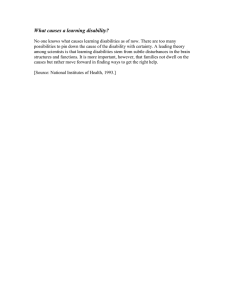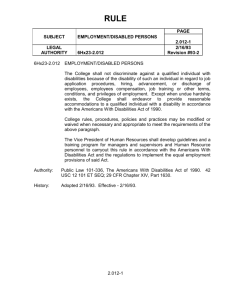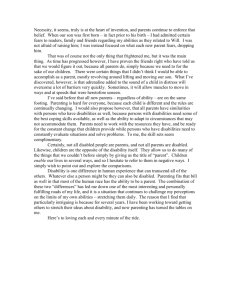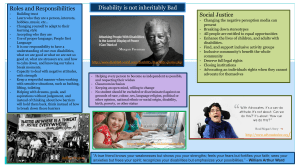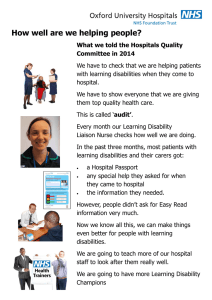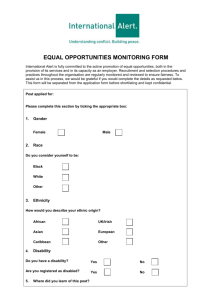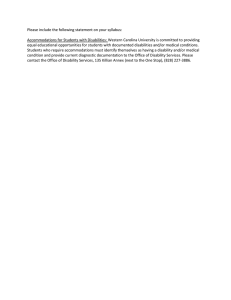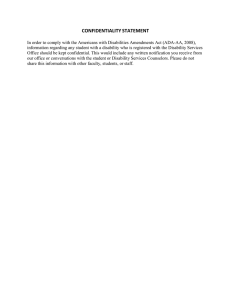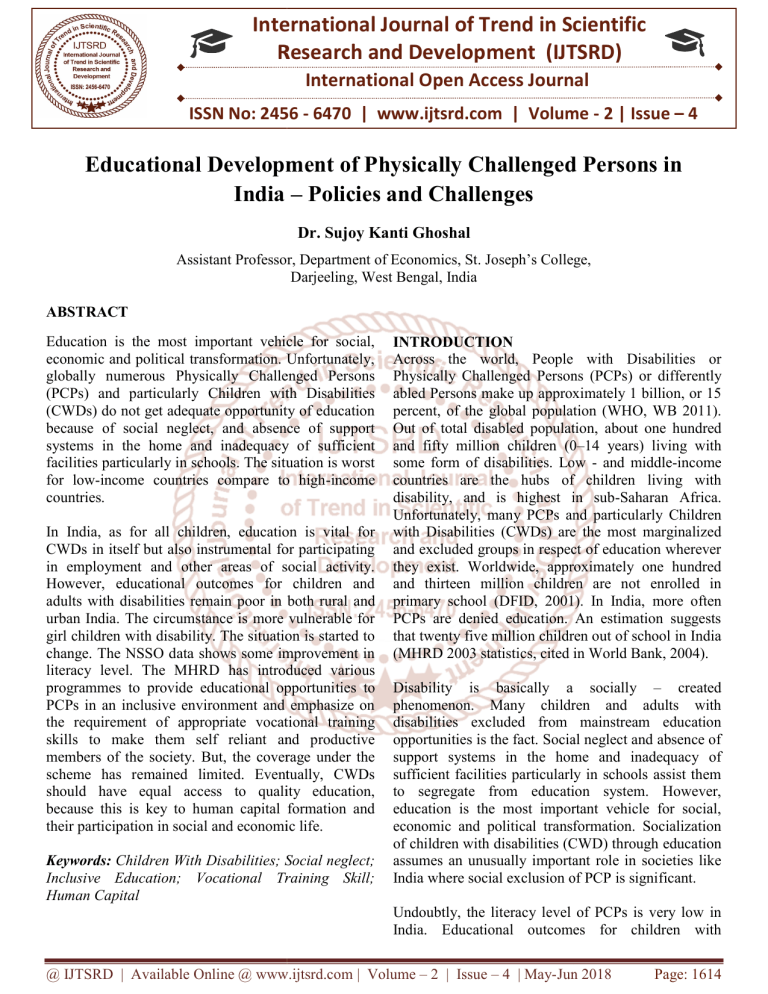
International Journal of Trend in Scientific
Research and Development (IJTSRD)
International Open Access Journal
ISSN No: 2456 - 6470 | www.ijtsrd.com | Volume - 2 | Issue – 4
Educational Development of P
Physically
hysically Challenged Persons in
India – Policies and Challenges
Dr. Sujoy Kanti Ghoshal
Assistant Professor, Department of Economics, St. Joseph’s College,
Darjeeling, West Bengal, India
ABSTRACT
Education is the most important vehicle for social,
economic and political transformation. Unfortunately,
globally numerous Physically Challenged Persons
(PCPs) and particularly Children with Disabilities
(CWDs) do not get adequate opportunity of education
because of social neglect, and absence of support
systems in the home and inadequacy of sufficient
facilities particularly in schools. The situation is worst
for low-income
income countries compare to high
high-income
countries.
In India, as for all children, education is vital for
CWDs in itself but also instrumental for participating
in employment and other areas of social activity.
However, educational outcomes for children and
adults with disabilities remain poor in both rural and
urban India. The circumstance is more vulnerable for
girl children with disability. The situation is started to
change. The NSSO data shows some improvement in
literacy level. The MHRD has introduced various
programmes to provide educational opportuni
opportunities to
PCPs in an inclusive environment and emphasize on
the requirement of appropriate vocational training
skills to make them self reliant and productive
members of the society. But, the coverage under the
scheme has remained limited. Eventually, CWDs
should
hould have equal access to quality education,
because this is key to human capital formation and
their participation in social and economic life.
Keywords: Children With Disabilities; Social neglect;
Inclusive Education; Vocational Training Skill;
Human Capital
INTRODUCTION
Across the world, People with Disabilities or
Physically Challenged Persons (PCPs) or differently
abled Persons make up approximately 1 billion, or 15
percent, of the global population (WHO, WB 2011).
Out of total disabled population, about one hundred
and fifty million children (0–14
(0
years) living with
some form of disabilities. Low - and middle-income
countries are the hubs of children living with
disability, and is highest in sub-Saharan
sub
Africa.
Unfortunately, many PCPs and particularly
particul
Children
with Disabilities (CWDs) are the most marginalized
and excluded groups in respect of education wherever
they exist. Worldwide, approximately one hundred
and thirteen million children are not enrolled in
primary school (DFID, 2001). In India, more often
PCPs are denied education. An estimation suggests
that twenty five million children out of school in India
(MHRD 2003 statistics,
cs, cited in World Bank, 2004).
Disability is basically a socially – created
phenomenon. Many children and adults with
disabilities excluded from mainstream education
opportunities is the fact. Social neglect and absence of
support systems in the home and inadequacy of
sufficient facilities particularly in schools assist them
to segregate from education system. However,
education
ducation is the most important vehicle for social,
economic and political transformation. Socialization
of children with disabilities (CWD) through education
assumes an unusually important role in societies like
India where social exclusion of PCP is significant.
signi
Undoubtly, the literacy level of PCPs is very low in
India. Educational
ducational outcomes for children with
@ IJTSRD | Available Online @ www.ijtsrd.com | Volume – 2 | Issue – 4 | May-Jun
Jun 2018
Page: 1614
International Journal of Trend in Scientific Research and Development (IJTSRD) ISSN: 2456-6470
disabilities remain very poor. Most of them do not get
the full benefit of education. However, Indian polity
has started to show some concern for PCPs student.
Education is crucial to lift up the socio-economic
status of PCP. Though, education of disabled people
has not received adequate attention and resources that
it requires. PCPs, few who are enrolled in schools are
not provided equal opportunity for middle, secondary
and higher education levels. At the best they are
currently educated illiterates, without any capacity
development for earning their livelihood.
However, the situation began to change in India.
Indian polity has started to realize as for all people,
education is vital for children and adults with
disabilities in itself and also instrumental for
participating in employment and other areas of social
activity. The MHRD has introduced various
programmes to provide educational opportunities to
PCPs in an inclusive environment. Government of
India also realizes the requirement of appropriate
vocational training skills to make them self reliant and
productive members of the society. But, the coverage
under the scheme has remained limited. Here we
cannot deny the role of NGOs.
OBJECTIVE
Disability is a social fact. Socio-economic
empowerment of PCP is significant. Education is the
most important instrument to develop the socioeconomic status of disabled people. The objective of
the present paper is to widen the opportunities of
education for children and adult with disabilities to
empower the disabled people.
MEHODOLOGY AND DATA SOURCES
Investigation is made in some vital areas of
empowerment and negligence in order to address the
problems of integrating the PCP with the society.
Societal awareness and administrative measures and
policies are two important areas.
The study will be undertaken with the help of
published Government and private information.
Publications and reports of UNO, WHO and other
international bodies have been also utilized.
Secondary published and unpublished sources are the
main source of information. Census and NSSO are
two important sources of quantitative sources of
disability in India.
DISABILITY
–
CONCEPT
AND
UNDERSTANDING
Concept of disability is vital. Historically, the field of
special education founded on conceptions of disability
originating within scientific, psychological, and
medical frameworks. Traditional understandings of
disability in special education have inadvertently
inhibited formulation and modification of hypothesis,
limited research methods, narrowed pedagogical
practice, and contributed largely in formulating
policies for educating persons with disabilities.
Disability is a dynamic phenomenon - modified by
changes in environment (Jahiel, 2007) and academic
understanding. Concept and understanding of human
disability are observed to be undergoing continuous
modification and consequently administrative
attention across the world. However, the central
concerned in modern debates appears to be ‘how one
should view the presence of a disability’ (Barnes,
2009).
The word disability as generally accepted, has
superseded and outmoded the now deemed offensive
terms such as “crippled” or “handicapped”, but has
not yet been surpassed by newer coinages such as
Differently Abled (Concise Oxford English
Dictionary, 2008). Convergence in conceptualization
is desirable, unfortunately universally accepted
definition of disability is yet to emerge and according
to some researchers probably impossible to achieve.
Still, different international organizations discussed
the concept of disability in diverse ways.
World Health Organization (WHO) has addressed the
disability issue and provides a conceptual framework
for disability with three significant aspects or issues –
impairment, disability, handicap; they are interrelated
and overlapping in some sense. We may observe
some hierarchical order in conceptualization.
Impairment is "any loss or abnormality of
psychological, physiological, or anatomical structure
or function". Disability is a "restriction or lack
(resulting from an impairment) of ability to perform
an activity in the manner or within the range
considered normal for a human being". Handicap is a
"disadvantage for a given individual, resulting from
an impairment or disability that limits or prevents the
fulfilment of a role that is normal (depending on age,
sex and social and cultural factors) for that
individual".
@ IJTSRD | Available Online @ www.ijtsrd.com | Volume – 2 | Issue – 4 | May-Jun 2018
Page: 1615
International Journal of Trend in Scientific Research and Development (IJTSRD) ISSN: 2456-6470
In 2001, the "International Classification of
Functioning and Disability" (ICF) explains the
concept of "disability," or "functional" abilities or
inabilities as an umbrella concept applicable both for
the body perspective, and to the individual and society
perspective.
they have been based on various criteria of
ascertaining abnormality or pathologic conditions of
persons.
The various definitions of disability in Indian context
summarized below –
In India, disability condition has been introduced
essentially following the medical model and, as such,
Definition of Persons with Disabilities
Statute
Section
Definition
Persons with Disabilities 2(i)
disability means- blindness; low vision; leprosycured;
(Equal
Opportunities,
hearing impairment; locomotor disability; mental
Protection of Rights and
retardation; mental illness. The statute then goes on to
Full Participation) Act, 1995
define each of the conditions on a severity scale.
(hereinafter PWDA)
2(t)
person with disability means a person suffering from
not less than forty percent of any disability as certified
by a medical authority
Rehabilitation Council of 2(c)
India Act, 1992
Mental Health Act, 1987
National
Welfare
Autism,
Mental
Multiple
1999
2(l)
Trust for the 2(j)
of Persons with
Cerebral Palsy,
Retardation and
Disabilities Act,
2(h)
handicapped means – visually handicapped; hearing
handicapped; suffering from locomotor disability; or
suffering from mental retardation
mentally ill person means - a person who is in need of
treatment by reason of any mental disorder other than
mental retardation.
person with disability means - a person suffering from
any of the conditions relating to autism, cerebral palsy,
mental retardation or a combination of any two or more
of such conditions and includes a person suffering from
severe multiple disability
multiple disabilities means a combination of two or
more disabilities as defined in clause (i) of section 2 of
PWDA.
EDUCATIONAL STATUS OF PCP – GLOBAL
AND INDIAN CONTEXT
Disability cannot be regarded as ‘a mere physical
fact’. It is a social issue. Society distinguishes
between ‘a normal and socially functional human
being’; and those belonging to complementary class.
Thus conceptualization ‘reflects society’s self image’
needless to state that prevailing social condition plays
a significant role in framing the definition and
branding. That is the main source of discrimination.
The society has to weed it out.
Education is an effective tool for socio-economic
empowerment, which steps up development of talents,
retrieves rights and paves way for career building and
future of PCPs. However, many children and adults
with disabilities have historically been excluded from
mainstream education opportunities in all over the
world. Thus enabling conditions for promoting
inclusive education for disabled children needs
specific measures to attract disabled children.
There is very little accurate information available on
the extent and nature of disability among children
globally – and even less on the degree of exclusion
from education faced by children with disabilities.
Nevertheless, the data that is available undeniably
shows that disabled children have far poorer
educational opportunities, compared to non-disabled
peers. According to the 2004 World Health Survey
found that respondents with a disability had
significantly lower rates of primary school
completion. The situation is more vulnerable in lowincome countries.
@ IJTSRD | Available Online @ www.ijtsrd.com | Volume – 2 | Issue – 4 | May-Jun 2018
Page: 1616
International Journal of Trend in Scientific Research and Development (IJTSRD) ISSN: 2456-6470
In India, Census and NSSO are two important sources
on disability. Both sources depict the gloomy and
depressing picture of educational status of disabled
population as compared to the general population
trends. Even among disabled literates, significant
proportions were educated only up to primary or
middle level both in rural and urban areas. Higher
education for this section of people is insignificant.
The situation is worst for girl children with disability.
However, some improvement shows in NSSO data.
Global Education Outcomes for Disabled and Not Disabled Respondents
Individuals
Low-Income
High-Income
All Countries
Countries
Countries
Not
Disabled Not
Disabled Not
Disabled
Disabled
Disabled
Disabled
(%)
(%)
(%)
(%)
(%)
(%)
Primary
Male
55.6
45.6*
72.3
61.7*
61.3
50.6*
School
Female
42.0
32.9*
72.0
59.3*
52.9
41.7*
Completion 18-49
60.3
47.8*
83.1
69.0*
67.4
53.2*
50-59
44.3
30.8*
68.1
52.0*
52.7
37.6*
60&Above 30.7
21.2*
53.6
46.5*
40.6
32.3*
Source: World Health Survey. Geneva, World Health Organization, 2002–2004
(http://www.who.int/healthinfo/survey/en).
Note: Estimates are weighted using WHS post-stratified weights, when available (probability weights
otherwise). * t-test suggests significant difference from “Not disabled” at 5%.
Percentage Distribution of Educational Status of Disabled population by Sector in India
Educational Status
2002
1991
Rural
Urban
Rural
Urban
Illiterate
59.0
40.0
70.1
46.2
Primary
24.4
28.8
20.3
29.8
Middle
9.7
13.7
5.3
11.0
Secondary
3.8
7.8
2.3
6.4
Higher-Secondary
2.1
5.1
0.8
2.8
Graduation and Above
1.0
4.6
0.4
3.1
Not-Reported
0.1
0.1
0.8
0.8
Vocational Training Received 1.5
3.6
1.2
3.1
Engineering
20
25
20.2
26.6
Non-Engineering
80
75
79.8
73.4
All
14085000 4406000 12652000
Source: NSSO Rounds 47th and 58th, 1991, 2002
3502000
Percentage Distribution of Educational Level of Disabled Persons in India: by sex
Educational Level
India
Persons
Males
Females
Illiterate
45.48
37.63
55.44
Literate
54.52
62.37
44.56
Literate but below Primary
10.59
11.38
9.58
Primary but below Middle
13.26
14.65
11.49
Middle but below Matric/Secondary
9.13
10.79
7.03
Matric/Secondary but below Graduate
12.86
15.54
9.45
Graduate and Above
4.65
5.60
3.44
Source: Census, 2011, India
@ IJTSRD | Available Online @ www.ijtsrd.com | Volume – 2 | Issue – 4 | May-Jun 2018
Page: 1617
International Journal of Trend in Scientific Research and Development (IJTSRD) ISSN: 2456-6470
Percentage of Children With Disabilities
Age Groups (Years)
Children With Disabilities (%)
0–4
1.14
5–9
1.54
10 – 19
1.82
Source: Census, 2011, India
POLICY FOR PCP – FROM SPECIAL EDUCATION TO INCLUSIVE EDUCATION
The history of education of PCPs is a progression from segregation to integration, and now to inclusion. In
India, the educational system supports exclusion of disabled children from the education system, as
accessibility as well as methodology of teaching in the schools in unfavorable for them. Most of the disabled
children are unable to reach schools due to unfriendly communication and accessibility approach of the schools.
Even the staff available in the schools is not trained to provide appropriate educational training to the disabled
children. Thus enabling conditions for promoting inclusive education for disabled children needs specific
measures to attract disabled children.
In this connection the various commissions, committees, Acts, schemes have been made, implemented and
constituted for PCPs in India, for their education, by collaboration with Government and Nongovernmental
organization. Govt. also facilitates learning through Augmentative and Alternative Modes for PCPs. The NIHH
runs the Indian Sign Language Cell for the development of teaching materials to teach Indian Sign Language
(ISL), training of ISL interpreters, to train deaf persons to become sign language teachers, sign language
training for hearing staff at educational institutions, for hearing handicapped parents and family members and
documentation of sign language vocabulary used in different regions of the country and their variations.
Policies related to Education for CWD in India –
Education for CWD is significant. A considerable portion of CWD in India excluded from education system.
However, Government of India started to take some serious steps for CWD. The various policies related to
education for CWD in Indian context summarized below –
@ IJTSRD | Available Online @ www.ijtsrd.com | Volume – 2 | Issue – 4 | May-Jun 2018
Page: 1618
International Journal of Trend in Scientific Research and Development (IJTSRD) ISSN: 2456-6470
Policy
Sargent report/ The Central
Advisory Board of Education
(CABE) report, 1944
The
National
Education
commission/
Kothari
Commission(1964-66)
Objective
This report is the milestone in the policy on ‘Integration’ of disabled children in
general schools in India.
It was evidently in favor of making education of the handicapped an integral
part of the general education system and recommended a Cell, at NCERT, to
study in this country and abroad, the work being done in the field of education
for the handicapped and prepare material for their teachers.
National Education
(NPE), 1968
Policy The report suggested the expansion of education facilities for physically and
mentally handicapped children and the development of ‘Integrated Programme’
enabling handicapped children to study in regular schools.
National Policy on education Stressed the need for integrating children with special needs with other groups
(NPE), 1986 and Programme and envisaged some measures to integrate children with physical and mental
of Action, 1992
impairment to mainstream educational institutions.
Bahrul Islam Committee, 1988
It mentioned that the state should endeavor to provide free and universal
elementary education to children with physical and mental disabilities. The state
shall also provide assistance to them for education and training at the secondary
and higher levels. It also emphasized promotion of integrated education and
continuation of residential education.
Programme of Action 1990, Stressed on the service training programmes for teachers, orientation
MHRD
programmes for administrators, development of supervisory expertise in the
resource institutions for school education at the district and block levels, and
provision of incentives like supply of aids, appliances, textbooks and school
uniforms.
Integrated Education for the The Scheme provided funding for rehabilitation aids and equipment,
Disabled Children (Revised educational material, training of resource teachers, establishment of preschool
1987,1989 and 1992)
and parent counseling centers, transport allowance, removal of architectural
barriers in school buildings, etc.
Project Integrated Education The National Council for Educational Research and Training implemented
for the Disabled (PIED), 1987
PIED with the financial support from UNICEF, which provided support for the
development of instructional material, training of personnel, mobilizing
community support, training of parents and coordination of the project in
remote and rural areas and difficult places. It also extended support for
identification and assessment of children with disabilities, establishment of
resource rooms, provision of aids and appliances and allowances for children
with disabilities.
District Primary Education DPEP is an excellent and bold step towards promotion of inclusive education of
Programme (DPEP)
children with disabilities. It emphasized to put local communities in charge of
education in their area and enhance investments in primary education for
inclusive education either in the formal system or through non formal education
programme.
The National Action Plan for Emphasizes on the inclusion of children and young PWDs in all general
Inclusive
Education
Of educational settings from Early Childhood to Higher Education.
Children and Youth with
Disabilities
(IECYD),
developed by the MHRD, 2005
Sarva Shiksha Abhiyan (SSA) Stride towards achieving the long cherished goal of Universalization of
(Education for All Campaign)
Elementary Education through a time bound integrated approach, in partnership
with states. It makes a provision up to Rs.1200 per child for integration of
disabled children as per specific proposal.
@ IJTSRD | Available Online @ www.ijtsrd.com | Volume – 2 | Issue – 4 | May-Jun 2018
Page: 1619
International Journal of Trend in Scientific Research and Development (IJTSRD) ISSN: 2456-6470
Secondary Education Schemes and Programmes in India –
The Central Advisory Board of Education (CABE) is the highest advisory body to the Central and State
government in the field of education. The committee report on the Universalization of Secondary Education
(June, 2005) recommended that the guiding principle of Universal Secondary Education should be Universal
Access, Equality and Social Justice, relevance and Development, and Structural and Curricular Considerations.
The CABE Committee Report on “Girls’ Education and the Common School System” has recommended
making the curriculum flexible and appropriate to accommodate the diversity of school children, including
those with disability in both cognitive and non-cognitive areas. The various schemes and programs related to
education for disabled people in Indian context summarized below Scheme
Objective
Coverage
Rashtriya
Making secondary education of good quality Government
Madhyamik
available, accessible, and affordable to all young secondary
Shiksha Abhiyan people in the age group of 15–16 years, removing schools
gender, socio-economic, and disability barriers, throughout the
making all secondary schools conform to prescribed country
norms, achieving a GER of 75 percent in secondary
education in a period of five years, providing
universal access to secondary level education by
2017 and universal retention by 2020.
Inclusive
To enable them to continue their education at the Covers children
Education
secondary stage in an inclusive environment in with disabilities in
for the Disabled regular schools.
the
secondary
at
stage from classes
Secondary Stage
IX to XII
Policies related to Higher Education for PCP in India –
The outcome of higher education for PCP is unsatisfactory in India. However, University Grants Commission
has issued instructions to all universities and colleges for providing 3% reservation (horizontally) in admission
for PCP students, reservation of 3% for the PCPs in the appointment of Lecturers and in admission of to
courses, relaxation of 5% for NET admission, and relaxation in upper age limit up to 5 years to PCPs in
admissions. The various schemes and programs related to higher education for disabled people in Indian
context summarized below –
Scheme and
Objective
Programme
Higher Education for Aims to create an environment in the higher education institutions
Persons with Special including Universities to create awareness about the capabilities of
Needs (HEPSN)
PWDs by constructing facilities to improve accessibility, purchase
of equipment, to enrich learning through establishment of
Enabling Units, providing access and special equipment to
augment educational services.
Financial Assistance to The scheme is formulated to help visually challenged permanent
Visually-Challenged
teachers to pursue teaching and research with the help of a reader
Teachers (FAVCT)
by using teaching and learning aids.
Upgradation of existing This Scheme has been formulated with the aim to integrate
Polytechnics
to physically PwDs into maintaining technical and vocational
integrate
physically education.
challenged persons
Indira Gandhi National IGNOU provides several diploma and certificate courses for
Open
University PwDs.
(IGNOU)
Establishment of Equal To make colleges and universities more responsive to the needs
@ IJTSRD | Available Online @ www.ijtsrd.com | Volume – 2 | Issue – 4 | May-Jun 2018
Page: 1620
International Journal of Trend in Scientific Research and Development (IJTSRD) ISSN: 2456-6470
Opportunity
Universities
Cells
in and constraints of the disadvantaged social groups, the
Commission has financed Institutions to establish Equal
Opportunity Cells to see the effective implementation of policies
and programmes for disadvantaged groups and to provide
guidance and counselling in academic, financial, social and other
matters.
National Mission on In order to facilitate the PwD students, the focused interventions
Education
through have been incorporated in the Mission are Unicode font to provide
Information
and support in various languages and for visually impaired students.
Communication
Technology
Scholarships for PCP in India –
In India, the policy related to education for PCPs is satisfactory compare to other areas. Government of India
started different types of scholarships for PCP to boost up their self-confidence. The various scholarships
related to education for disabled people in Indian context summarized below Scholarships
Objective
National
Means-cum-Merit The provision to award 1 lakh scholarships every year to selected
Scholarship (NMMS), 2008
candidates in Classes IX–XII and some State Government provide
scholarships to students with disabilities from standard I to VIII i.e.
upto 14 years.
KendriyaVidyalaya/Navodaya Under this 3% reservation in admission and exemption from payment
Vidyalaya
of Vidyalaya Vikas Nidhi and tuition fee is provided to students with
disabilities, covered in the PWDA.
National Scholarships for Under this scheme, the MoSJE awards 500 new scholarships every
PwD
year for pursuing post matriculation, professional and technical
courses of more than one year duration with respect to students with
cerebral palsy, mental retardation, multiple disabilities and people
with profound or severe hearing impairment, scholarship are awarded
for pursuing studies from IX standard onwards.
Students with 40% or more disabilities whose monthly family income
does not exceed 250 USD are eligible for scholarship. The scholarship
is provided to the students pursuing Graduate and Post Graduate level
courses; pursuing diploma and certificate level professional courses.
In addition, the students are also reimbursed with the course fee.
Financial assistance under the scheme is also given for computer with
editing software for blind/ deaf graduate and postgraduate students
pursuing professional courses and for support access software for
cerebral palsy students.
GyanPrabha
Scholarship Under the scheme, financial assistance is provided to the disabled to
Scheme
pursue vocational training/professional courses leading to skill
development and employment for PwDs. The scheme was launched in
to provide financial assistance with the monthly family income limit
of 250 US Dollar and condition of minimum 50% marks for renewal
of the scholarship for every year has been waived.
Scholarship
and
other Various state governments extend scholarships to PwDs for
schemes
of
State Graduation, Post Graduation and Engineering and Professional
Governments for Higher courses that range from 2 US Dollar to 25 US Dollar per month.
Education
Besides these Readers Allowance from 1.61 US Dollar to 26 US
Dollar per month and Hostel allowance is offered ranging from 1.61
US Dollar to 3.87 US Dollar per month is for graduation, post
graduation and professional courses.
@ IJTSRD | Available Online @ www.ijtsrd.com | Volume – 2 | Issue – 4 | May-Jun 2018
Page: 1621
International Journal of Trend in Scientific Research and Development (IJTSRD) ISSN: 2456-6470
2456
CONCLUSION
Overall, the educational
ducational outcomes for children and
adults with disabilities remain poor across the world.
No exception in India also. However, in India, the
policy related to education for disabled people is
satisfactory compare to other areas. The NSSO data
depicts somee improvement in literacy level. Although,
Indian polity faces challenges to implement the
policies. Here, NGOs play a significant role.
Majority of PCPs are not provided equal opportunities
for education and even few who are enrolled in
schools are nott provided equal opportunity for middle,
secondary and higher education levels. Situation is
vulnerable for CWDs particularly in low
low-income
countries. CWDs should have equal access to quality
education, because this is key to human capital
formation and their
eir participation in social and
economic life. In addition, Government should shown
concern for vocational training of PCPs.
The study shows that respondents with a disability
had significantly lower rates of primary school
completion compare to non-disabled
disabled in all the
countries. The situation is more vulnerable in low
lowincome countries compare to high-income
income countries.
Disabilityy is a social phenomenon. Empowerment of
PCPs is essential. Education is the most important
vehicle to develop the socio-economic
economic status of PCP.
The National Policy for PCPs voiced the need for
mainstreaming of PCPs in the general education
system through inclusive education, identification of
CWDs through regular surveys, enrolment in
appropriate and disabled friendly schools till
successful completion of education. However, there
has much scope to improve the circumstances.
Acknowledgement
The author
or is grateful to Bipul Malakar, Retired
Professor, University of Jadavpur, for his valuable
suggestions to prepare this paper.
References
1. Convention on the Rights of Persons with
Disabilities (2006), New York, United Nations.
Census report, 2011.
2. Education
cation for All global monitoring report
(2009), Regional overview: sub-Saharan
sub
Africa.
Paris, United Nations Educational, Scientific and
Cultural Organization (http://unesdoc.unesco.org).
3. Ministry of Human Resource Development
(2004), Education for all: India
In
marches ahead.
New Delhi: Government of India.
4. Ministry of Human Resource Development.
(1992), Integrated Education for Disabled
Children Scheme. New Delhi: Government of
India.
5. Ministry of Human Resource Development.
(1986),
Ministry
of
Human
Resource
Development: National Policy of Education 1986.
New Delhi: Government of India.
6. Ministry of Social Justice and Empowerment
(2007), Disability Policy and programs:
experiences and prospects for future. Presentation
made at the People with disabilities in India:
status, challenges and prospects workshop held at
World Bank. New Delhi: India. NSSO (2003),
Disabled Persons in India, NSS 58th round (July –
December 2002).. National Sample Survey
Organisation: New Delhi.
7. People with disabilities in India: from
commitments
mmitments to outcomes (2009), Washington,
Human Development Unit, South Asia Region,
World Bank.
8. Singal, N. (2008b), Working towards inclusion:
Reflections from the classroom. Teaching and
Teacher Education, 24, 1516-1529.
1516
9. Singal,, N. (2006a), Inclusive education in India:
international concept, national interpretation.
International Journal of Disability, Development
and
Education,,
53
(3),
351-369.
351
@ IJTSRD | Available Online @ www.ijtsrd.com | Volume – 2 | Issue – 4 | May-Jun
Jun 2018
Page: 1622

